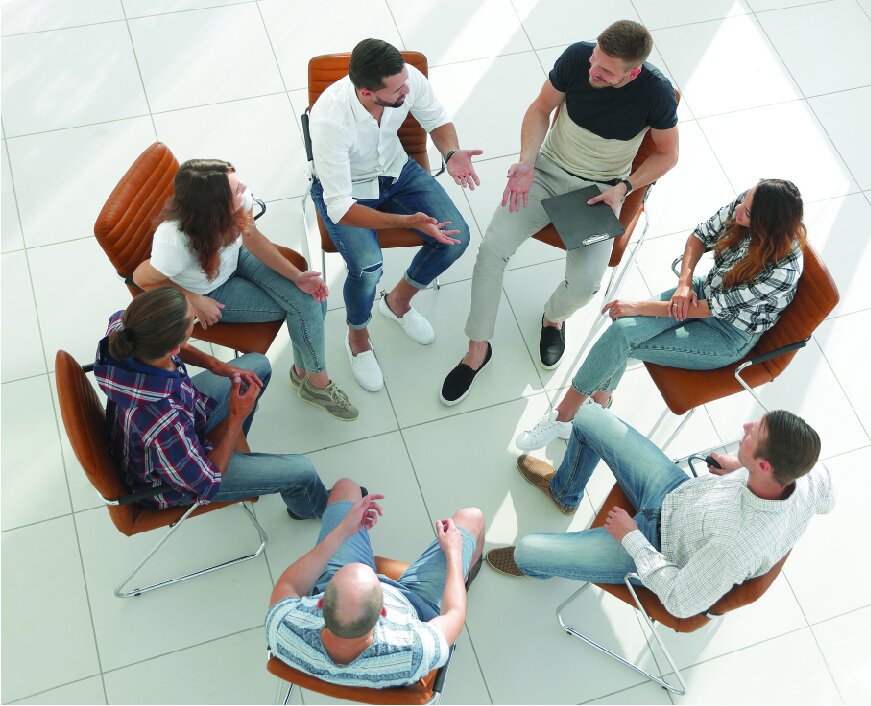Peer Learning: Harness Collective Intelligence
When faced with interconnected, complex challenges, we need to harness multiple perspectives and the collective intelligence of the organisational system we are part of. Studies have also shown the importance of “social learning”, i.e. collaborative exploration and problem-solving, shared reflection and mutual support.
One of the ways to achieve this is to use peer learning tools such are Action Learning, Peer Groups and Co-Development. They usually comprise a small group of people, who meet regularly (between 1 – 3 hours) to support each other with key challenges they are facing. Peer learning can be self-directed and self-organised within the organisation or implemented with the help of an external facilitator.
Benefits of Peer Learning
Fosters reflection spaces, deep listening and a sense of community
Collaborative learning enhances perspective-shifting and critical thinking
Builds relationships, trust and psychological safety that allow open examination of an issue and creating shared solutions
Deepens the impact of any formal “classic” training through applied learning and a space for skill development
Brings tacit knowledge and experience out into the open and makes it available to peers
Strengthens meeting management and communication skills by rotating facilitation and practising constructive feedback and dialogue
Method: Co-Development
The peer learning methodology “Co-Development” can be easily implemented within an organisation or across a network of organisations. The process consists of one person (the “client”) sharing his/her challenge with others (the “consultants”) in a structured facilitated session, taking place over a series of months. Adrien Payette and Claude Champagne, the creators of Co-Development, define it as a “development method for those who believe that learning from one another can help them to improve the way they do things.”
In the following we will present a short version of Co-Development that lasts a minimum of 60 minutes, but can be extended to give more time for exploration and formulating next steps. One case is treated in each session. We recommend regular sessions, e.g. once or twice a month for at least 6 months.
Process Overview
1. Welcome: Facilitator welcomes all, brief check-in “How are you coming to this session” (sensations, emotions, thoughts); optional: moment of silence. In the first session, we recommend you agree some ground rules, e.g. no phones, open listening, non-judgemental feedback;
2. Choose Case/Client: Facilitator invites all to briefly (!) share what they want to work on. Not everyone will have a topic. The topic needs to be unresolved and current, e.g. a decision to make, how to deal with a conflict or communication. It is important that none of the consultants are personally involved in the chosen topic. All choose topic together according to importance/ urgency.
3. Present Case: Facilitator asks Client: “What do we need to know about this situation to be able to help? and “Tell us what you have done already to solve this issue?”. The Consultants listen in silence and write down any questions they might have.
4. Clarifying Questions: Consultants ask clarifying questions to better understand the issue. No solutions yet or questions like “have you tried xyz?” Instead ask: How many? Where? With whom? How? Who? What? The Client answers the questions one by one.
5. Clear Request: Facilitator asks Client to specify clearly: “What do you expect from the group – how can we help you with this issue?” Ensure the Client formulates a clear request, e.g. hearing others’ experiences, some recommendations, questions to reflect on …
6. Appreciation: Facilitator asks Consultants to each share a specific positive observation with the Client, e.g. how the Client has presented their challenge, how they have approached it, or what impact the case presentation has had on the consultant. Client doesn’t respond, simply takes the feedback as a gift.
7. Reflection: Consultants take 2 minutes in silence to prepare their best advice/ recommendations for the Client. Consultants, try and “put yourselves in the Client’s shoes”.
8. Share Advice: Consultants share their best advice. “If I were in your situation, I would ….” The Client listens in silence and takes notes as desired. NB: Facilitator needs to manage the time well – everyone has XY minutes to share. No commenting.
9. Client reviews and shares insights: Client shares his/her insights from the advice given and how this can help resolve the issue at hand. Insights can be either concrete actions, further questions, new perspectives or self-awareness. NB: This is not to evaluate the advice but to generate next steps. Client can also ask for subsequent follow-up or further help if desired.
10. Share Learning: All (including the facilitator) share a. what they have learned/what they are taking away (as insights) b. how they are leaving this session – one word (feelings, sensations).
11. Close: Appoint next facilitator and close meeting.
We recommend starting the process with a pilot group that runs for at least 3 months, then review and adapt as needed. Prepare a brief for the participants to explain the rationale and process of the initiative. You can start by inviting peer-level participants and later expand the initiative across different organisational levels (while avoiding direct reporting lines). Ideally, the participants remain the same over the course of the sessions, which promotes cohesion and deeper work over time as participants open up more.
Facilitated well, Co-Development or similar peer learning methodologies can provide a wonderful platform for deeper interactions, authenticity and trust to emerge as well as co-creating real solutions and innovation among your people.


